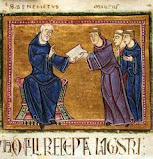My apologies if you were looking for my post yesterday morning. I was giving a retreat to Brother Bruno at our house up in the mountains of Sussex County, N.J. The following is a slightly edited version of my final conference to him this afternoon. It may be familiar t0 s90me of you, but its message bears repeating.
Scholars disagree on the exact identity of many of the figures: is that Isabel of Portugal or is it the goddess Hebe? Is that couple in the upper right corner Eve and Cain or Venus and Mars? In any case, it seems likely that many of the figures tell the story of the painful process by which a student in the middle ages would, by dint of long, hard work, pass through various stages and long years of study until he finally reached his goal and became a doctor of law or philosophy.
You can easily pick out Hercules, for example, in his lion-skin disguise, holding a club. He’s there to remind the students that university studies are as difficult as the twelve labors of Hercules.
 |
| Can you see the frog? |
Transformation is the central driving force in the world of living things, yet it is so common that we take it for granted. We’re used to the idea that seeds become flowers, caterpillars turn into butterflies, and acorns become oak trees. As common as this process is, however, it remains one of the great mysteries of nature: a creature actually stops being one thing in order to become something else.
This, then, is the symbolism of la rana. A frog begins life as something else, a tadpole. The purpose of a tadpole is to stop being a tadpole one day in order to become a frog. A tadpole whose life’s goal was to become the biggest, fattest, shiniest tadpole in the world would be missing the whole reason for being a tadpole in the first place—and would probably end up a very unhappy little creature. The tadpole has to die to its wiggling tail and sleek shape so that a new frog can come into the pond.
Jesus uses an image of transformation to teach one of his central ideas: “Unless the grain of wheat falls to the earth and dies, it remains just a grain of wheat.” What’s true of seeds, acorns, and tadpoles, he is saying, is true of me as well. Jesus never challenges me to be a better Christian, never asks me to improve, to become holier or more saintly. He never asks me to grow. He simply keeps asking me to be transformed—to die.
It’s clear enough that a caterpillar is meant to be transformed into a butterfly, and a tadpole into a frog. But what kind of being am I supposed to be transformed into? Saint Basil of Caesarea answers boldly: “A human being is a creature whose purpose is to become God.” Saint Paul announces the same thing to the Galatians, “It is no longer I who live, but it is Christ who lives in me.”
In order to be transformed into a new being, however, I have to follow Jesus’ example, and do what he did on the cross: let go of everything I am, everything I have, everything I’m familiar with. If I try to hold onto the comfortable predictability of gradual growth, I’ll be like the tadpole who just wants to be a bigger tadpole, and my life will have no real purpose. I can become Christ only in the dozens of daily deaths I die to my old self: when I reach out in love to someone at the risk of being rejected or hurt, or when I gamble everything in deep, self-abandoning prayer, or when I surrender to God’s will for me in some disagreeable task.
So, pray for Br. Bruno, that the Lord will be able to transform him next Sunday!





No comments:
Post a Comment